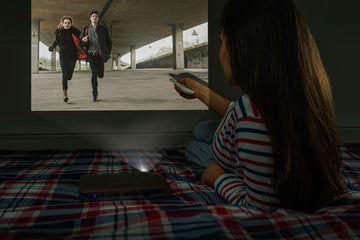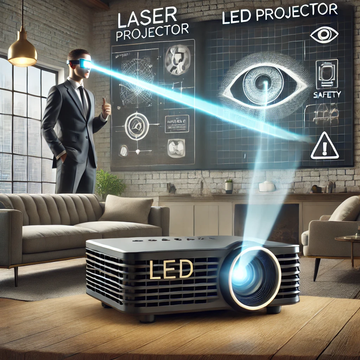Projector in bedroom
Projectors are a great way to enjoy a big-screen experience in the comfort of your own home. And with the latest projectors being more affordable and easier to set up than ever before, there's never been a better time to invest in one.
If you're thinking about using a projector in your bedroom, here are a few things to keep in mind:
Choose the right projector
There are a few key factors to consider when choosing a projector for your bedroom:
- Brightness: Lumens measure the brightness of a projector. For a bedroom projector, you'll want to choose a model with at least 2,000 lumens. However, it is important to note that lumens can be misleading, as some manufacturers or online sellers may inflate the lumen ratings of their projectors. For this reason, it is best to visit a showroom and see the projectors in person to compare their brightness for yourself.
- Resolution: Resolution determines the sharpness and clarity of the image. For a home cinema experience, you'll want to choose a projector with a resolution of at least 1080p but today it is not always true and has to depend on purity of the optics lens used too. Similar to our glasses, good lens give us almost all angle of clarity while some corners are blur, same applies in projectors
- Throw ratio: The throw ratio is the ratio of the projection distance to the image width. A projector with a super short throw ratio can produce a large image from a short distance, making it ideal for small spaces like bedrooms. i.e a 2.5m width small bedroom, you will get at least a queen bed width cinematic projection.
- Noise level: Some projectors can be quite noisy, so it's important to choose a model with a low noise level if you plan on using it in your bedroom. And do note, never cover the ventilation just because the fan is noisy or put projector on mattress or carpet, it is dangerous and can overheat.
Placement
Many modern projectors can be placed on the side and still produce a rectangular image. This is thanks to a feature called Image skew or keystone correction. Image skew correction allows you to adjust the image so that it is rectangular, even if the projector is not centered on the screen.
However, it is important to note that not all projectors have Image skew correction, and not all projectors with Image skew correction work equally well. Some projectors may experience image distortion or blurriness when Image skew correction is used, especially if it is used to a high degree.
For this reason, it is important to see the projector in person before you buy it to make sure that the keystone correction works well for your needs. You should also test the projector with different types of content to see how it performs.
Tips for using Image skew correction:
- Use keystone correction sparingly. The less Image skew correction you use, the better the image quality will be.
- If you need to use Image skew correction, try to use it vertically rather than horizontally. Vertical keystone correction is generally more effective than horizontal keystone correction.
- If you are experiencing image distortion or blurriness, try reducing the amount of Image skew correction you are using. If the problem persists, you may need to choose a different projector.
Set up your projector
Once you've chosen a projector, you'll need to set it up. This is a relatively straightforward process, but there are a few things to keep in mind:
- Placement: If you are planning on placing the projector on the side, make sure to choose a projector with Image skew correction and test it out in a showroom to make sure that it produces a clear image.
- Distance: The distance between the projector and the screen will determine the size of the image. Be sure to consult the projector's manual to find the optimal distance.
- Connections: You'll need to connect the projector to your source device,such as a Blu-ray player, game console,or streaming device. Most projectors have HDMI ports, but some older models may have VGA or DVI ports. More advanced projector has built-in streaming capabilities i.e youtube , netflix , app store and does not require external connections at all but the ease of use and streaming speed has to test in person.
Optimize your image
Once your projector is set up, you can optimize the image quality for your bedroom environment. This may include adjusting the brightness, contrast, and color settings. You may also want to try different projection modes, such as Game Mode or Cinema Mode. Some projector is equipped remote that can wireless focusing to make the image clear without leaving the comfy of your bed.
Create a cinematic experience
To create a truly cinematic experience in your bedroom, you can add a few finishing touches. For example, you can use a projector screen to improve the image quality and reduce ambient light. You can also use a media streamer to connect the projector to your streaming services such as apple tv, your unused laptop and other devices.
Here are a few additional tips for using a projector in your bedroom:
- Close the curtains or blinds: This will help to reduce ambient light and improve the image quality.
- Place the projector on a sturdy surface: This will help to prevent the image from shaking or blurring. i.e bed side table, dressing table, shelves, bed headboard, wardrobe, book shelves, etc.
- Use a remote control: This will allow you to adjust the projector's settings without having to get up





